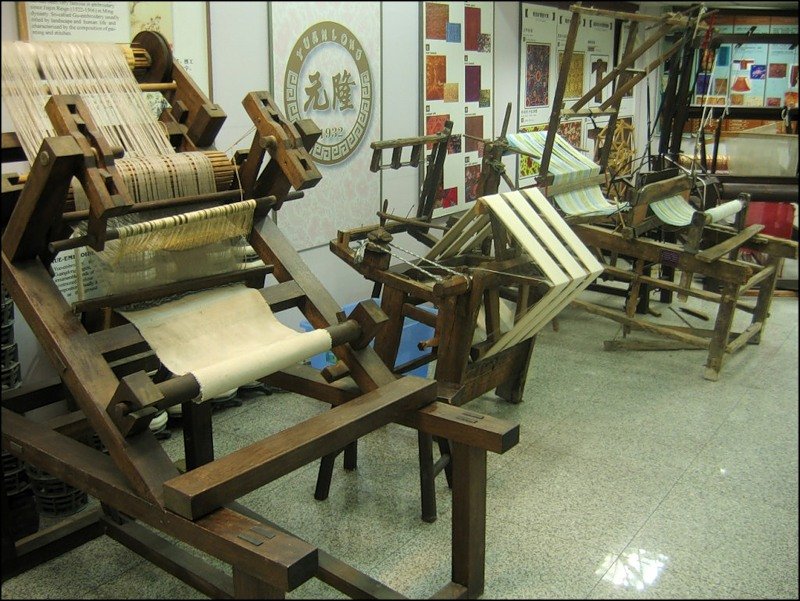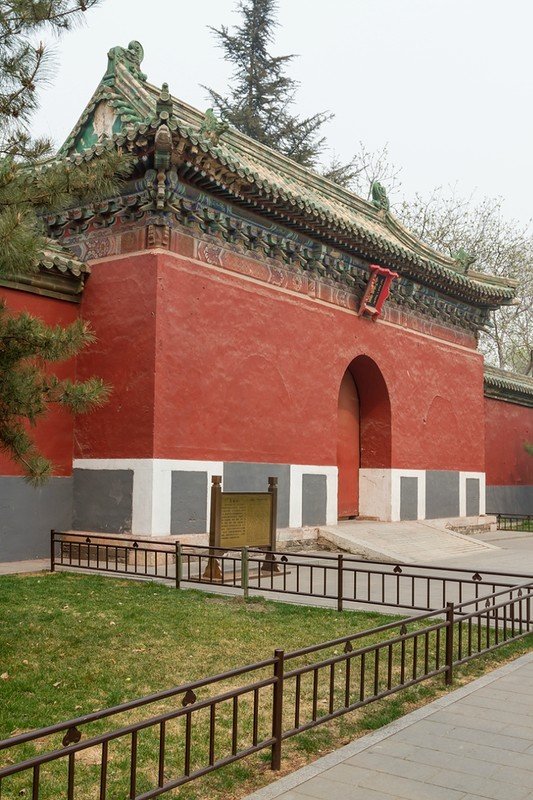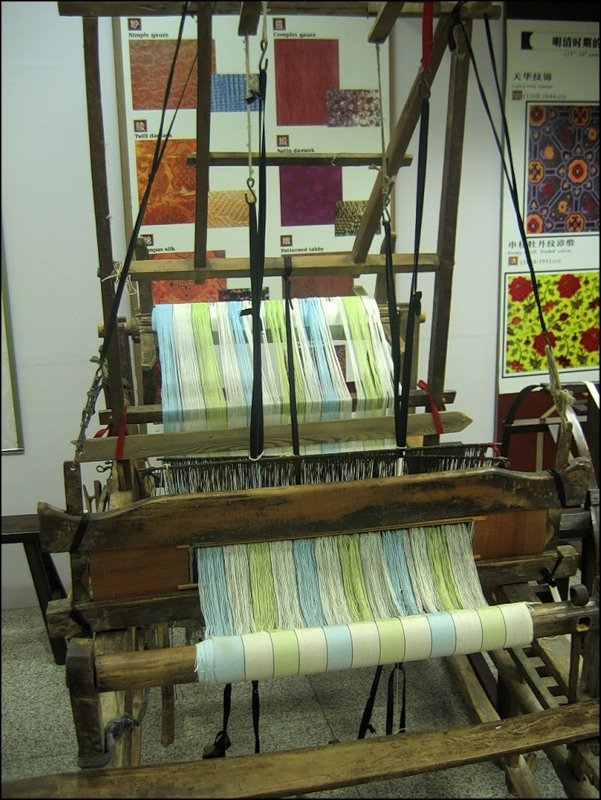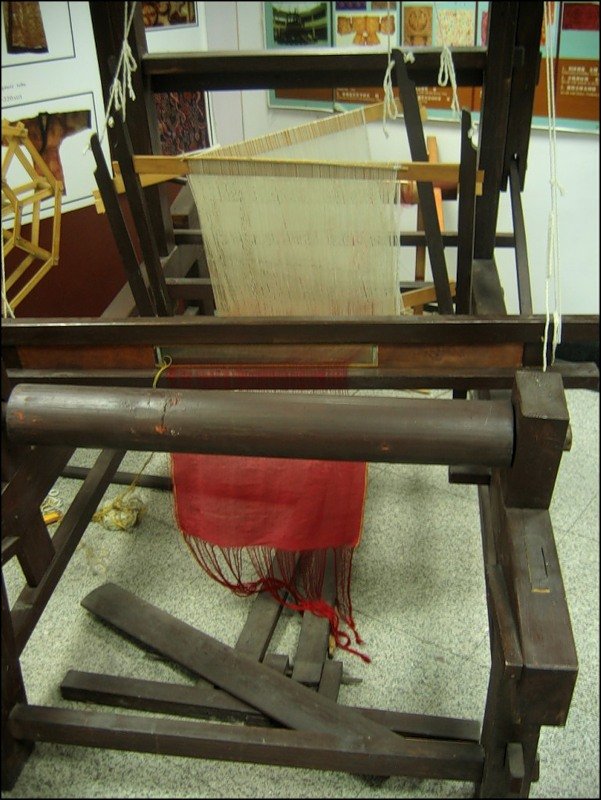
Vintage loom. With vintage pattern
Legends about the appearance of silk in China
Silk is a waste product of the silkworm hanging around a durable cocoon. But who first (or first) thought to unravel this cocoon and to twist the thread, and then weave the cloth? In China, many legends on this subject. The most famous of them connects the appearance with sericulture lei zu, the eldest wife of the mythical Emperor Huang-di, which, according to traditional sources, rules for celestial 2698 2598 BC
One day a young woman drinking tea in a garden under a mulberry tree. And in the Cup accidentally fell several silkworm cocoons. She began to remove them, the cocoons began to be unwound in a long thread. Then lei zu became to disrupt the rest of the cocoons hanging on the tree and unwinding them. From the resulting threads of it weave the fabric and sewed the clothes to her husband. Huang di heard about this opening, improved methods of breeding silkworms and produce silk. So there was sericulture and silk manufacturing.
For his discovery, lei zu also began to call Silin-Chi – Lady silk worm and she was considered the goddess-patroness of sericulture. Still in early April in Zhejiang province held festivities in honor of lei zu.
According to another legend, the most fantastic, once lived the father with the daughter, and they had a magical horse that could fly in the sky but also understand human language. One day the father went about his business and disappeared. Then his daughter made a vow: if the horse will be able to find her father, she would marry that horse. The horse found his father, and together they returned home. However, when the father found out about this oath, he was shocked, and to prevent this marriage, he killed the innocent horse. But when they began to skin the carcass, the skin of the horse suddenly picked up the girl and carried away. They flew and flew, and finally fell on a mulberry tree. And in that moment, when she touched the branches, she turned into a silkworm. She let out a long and thin thread, which expressed her sense of separation with your beloved horse.
Yet another legend that women of Ancient China accidentally discovered silk. They collected fruits from the trees and came upon a strange fruit white, too hard to eat. Then they began to cook them to soften, but they are hardly fit for food. In the end, women have lost patience and began to beat them with thick sticks. And then, and were open silk and silkworms. It turned out that white fruit was nothing like the cocoon of the silkworm!
The history of silk production
Existing legend — just a beautiful legends of antiquity. According to archaeological data, the properties of the silkworm and the secret of making silk was known already 5 thousand years ago. So, during archaeological excavations in different regions in China in the cultural layers of the III Millennium BC were found fragments of silk cocoons.
Yin Oracle bone inscriptions on animal bones and turtle shells the middle of the II Millennium BC contain the characters "silkworm", "mulberry", "silk", "silk fabric". The middle of I Millennium BC mulberry worms were already divorced in six States of China. Centers of sericulture were in the areas lying along the rivers the Yangtze and yellow river, as well as in Sichuan.
Since there is a tradition in spring the Empress opened the season of sericulture which lasted for six months. Since ancient times, silk was considered a female occupation.

Vintage looms. Silk market, Beijing
The first silk fabrics were very rare and expensive, so they were worn only by rulers and their family members. In all probability, inside the Palace, they are clothed in white robes, and ceremonial exits in yellow. With the expansion of production silk gradually became available to the court, and later the wider population.
Gradually, China emerged a cult of silk. In old Chinese texts mention sacrifices to the God of silkworm and mulberry of the sacred groves and reverence for the individual mulberry trees.

The gates of the temple of the deity of silkworm, Sanzang Beihai Park, Beijing
In the era of the Warring States (475-221 BC), silk and silk products widely spread in China in almost all sectors of the population. Mencius (372-289 BC), the "Second sage", offered on the perimeter of the "pit fields" to plant mulberry trees, to young and old walked in silk robes.
Silk was widely used in agriculture. In addition to use as a fabric for garments and embroidery, made of it strings for musical instruments, bowstrings for bows, made of fishing line fishing, and even paper. During the reign of the Han dynasty (206 BC – 220 ad) silk became a kind of a universal monetary equivalent: the peasants paid taxes in grain and silk, officials of the state were paid as well silk.
The value of the silk was calculated based on its length and was equated with gold. Silk became a de facto currency used in settlements with other countries. The important role of silk in Chinese culture, evidenced by the fact that from 5 thousand of the most commonly used hieroglyphs about 230 have the key "silk".

Vintage loom
The volume and quality of silk production gradually increased. The bright colors, the richness and perfection of the embroidery was striking. From the II century BC was arranged foreign trade, the famous silk Road. A key role in this process was played by Zhang Qian 张 骞 (?-114 BC), Chinese diplomat and Explorer who discovered China, and Chinese trade of the countries of Central Asia. Via the caravan routes, some of which existed before, were sent to the West the caravans, loaded with Chinese goods.
However, a number of historical and archaeological evidence suggests that in other countries about Chinese silk learned much earlier. So, in one of the Egyptian villages near Thebes and the valley of the Kings was discovered a female mummy, wrapped in silk, Dating from the XI century BC is Probably the earliest finding.
After the accession of the Tang dynasty (618-907) was founded by special weaving workshops, which produced the original ceremonial headdresses, and later colored silk fabric. The fabric was dyed with vegetable dyes: flowers, leaves, bark, roots. The main weaving centers were located on the territory of the modern provinces of Henan, Hebei, Shandong and Sichuan. Tanska era – the time of intensive trade silk, he discovered on the territory of modern Xinjiang, Turpan, Tajikistan and even in the North Caucasus.

Loom
The Greeks and Romans called China "the land of silk" – Serik. Among the nobility, the silk was very popular. It cost is extremely expensive, but, nevertheless, he willingly bought. Price could go up to 300 denarii – a Roman legionary wages for the whole year! Import of silk has begun to threaten the economy of the Roman Empire. In the year 380 the Roman historian Ammianus Marcellinus (C. 330-after 395) wrote that "the use of silk which was once restricted to notable, now has spread to all classes without distinction, even to the very lowest".
Barbara was also captivated by this amazing material. The goth, Alaric, captured Rome in the year 409, demanded, among other things, 4000 silk tunics.
But the secret of making silk for a long time remained unsolved. Offered a variety of explanations. So, Virgil (first century BC), for example, believed that the silk is made of fleece with leaves. The Greek historian Dionysius (first century BC) believed that silk is made from the flowers. It was suggested that shiny silk threads grow on trees, or that it created huge bugs, or it's made from the feathers of birds. Roman historian of IV century Ammianus Marcellinus presented this explanation: "Silk is made from the soil. Chinese soil is soft as wool. After watering and special processing, it can be used for the formation of silk threads".
The Chinese zealously guarded the secret of silk manufacture. Anyone who tried to translate abroad the eggs, larvae, silkworm cocoons, were executed. However, in Korea and then in Japan learned the secret of silk production. It is believed that in Korea about II century BC, brought him the Chinese who had emigrated there. On the Japanese Islands silk appeared in the III BC Then, in the fourth century, silk production was established in India.
There are several legends telling of how the technology of making silk was known in other countries. I agree one of them, a Chinese Princess was betrothed to a Prince of Khotan. Her fiance wanted his bride brought with them the seeds of the mulberry tree and silkworm larvae. According to another version, the Princess wanted to bring them to their new home. She hid seeds and larvae in his lush hair and took them outside of China. It happened about 440 years. And from there the secret of silk production spread throughout the world.
According to another polulegenda-proistoria, the secret divulged two Nestorian monk. About 550 g. they secretly in their hollow bamboo staves brought silkworm eggs and mulberry seeds Byzantine Emperor Justinian I (483-565).
Thus Byzantium became the first country outside the Western world, where there its sericulture. Church and state has created its silk workshops, monopolizing thus the production and also zealously guarding the secret of its production. In the sixth century the Persians had also mastered the art of silk weaving and created their own masterpieces.

Loom
Catholic prelates wore rich silk robes and adorned their altars. Gradually, the fashion for silk spread among the nobility. In VIII-IX centuries, silk was produced in Spain and four centuries later, silk was successfully produced cities of the Apennine Peninsula, few cities which gave its name to the tissues. It is believed that Italian silk originates from 2 thousand skillful masters, taken in the XIII century in Italy from Constantinople.
Today silk is produced in many countries of the world: China, Italy, India, Spain, and France. But still China is the largest in the world market exporter of raw silk and silk products.
